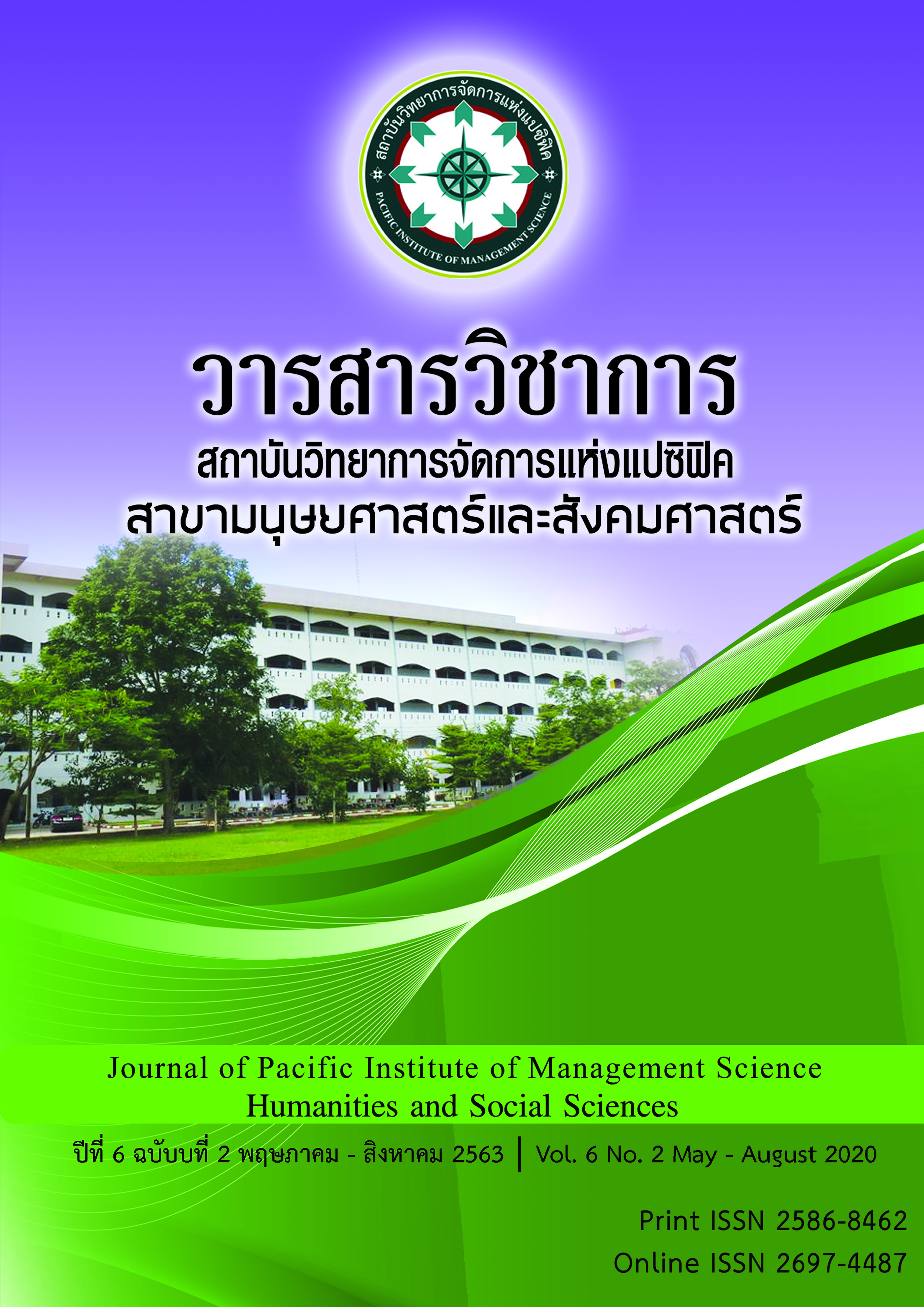Brand Equity, Trust, and Satisfaction Relating Brand Loyalty of TRUEMOVE H 3G+
Keywords:
Brand Equity, Trust, Satisfaction, Brand Loyalty, TRUEMOVE H 3GAbstract
The objectives of this research were to study (1) the relationship between brand equity, brand awareness, perceived quality, brand associations and brand loyalty of TRUEMOVE H 3G+; (2) the relationship between trust and brand loyalty of TRUEMOVE H 3G+; and (3) the relationship between satisfaction, process, physical evidence, people and brand loyalty of TRUEMOVE H 3G+.
This study was a survey research. The population was customers using the TRUEMOVE H 3G+ service in Bangkok area. The sample size was 400 samples. Data were collected using questionnaires and analyzed descriptively. Statistical analysis employed were percentage, means, standard deviation and correlation coefficient.
The results showed that (1) the relationship between brand equity, brand awareness, perceived quality, brand associations and brand loyalty of TRUEMOVE H 3G+ were at a high level and significantly correlated. (2) The relationship between trust and brand loyalty of TRUEMOVE H 3G+ were at a very high level, and significantly correlated. (3) The relationship between the satisfaction, process, physical evidence, people and brand loyalty of TRUEMOVE H 3G+ were at a very high level, and significantly correlated.
References
กัลยา วานิชย์บัญชา. (2545). การวิเคราะห์สถิติ: สถิติสำหรับการบริหารและวิจัย. พิมพ์ครั้งที่ 6. กรุงเทพฯ: สำนักพิมพ์ จุฬาลงกรณ์มหาวิทยาลัย.
กิตติ สิริพัลลภ. (2547). การตลาดมืออาชีพ. กรุงเทพฯ: บริษัท ซีเอ็ดยูเคชั่น จำกัด (มหาชน).
จิตตินันท์ เดชะคุปต์. (2539). เจตคติและความพึงพอใจในการบริการ. ใน จิตวิทยาการบริการ หน่วยที่ 8 -15. (พิมพ์ครั้งที่ 2). (น. 80 -95). นนทบุรี: มหาวิทยาลัย สุโขทัยธรรมาธิราช.
จุไรวรรณ ไชยพงศ์. (2554). ศึกษาความสัมพันธ์ระหว่างความพึงพอใจในการใช้โทรศัพท์มือถือกับความภักดีต่อตราสินค้าโทรศัพท์มือถือของประชากร อำเภอเมือง จังหวัดสมุทรสาคร. (วิทยานิพนธ์ปริญญาบริหารธุรกิจมหาบัณฑิต, มหาวิทยาลัยรามคำแหง).
ฉัตยาพร เสมอใจ. (2550). พฤติกรรมผู้บริโภค. กรุงเทพฯ: ซีเอ็ดยูเคชั่น
ชริณี เดชจินดา. (2535). ความพึงพอใจของผู้ประกอบการต่อศูนย์กำจัดกากอุตสาหกรรม แขวงแสมดำ เขตบางขุนเทียน จังหวัดกรุงเทพมหานคร. (วิทยานิพนธ์ปริญญามหาบัณฑิต, มหาวิทยาลัยมหิดล)
ธนียา ปัญญาแก้ว. (2541). ปัจจัยที่มีอิทธิพลต่อความพึงพอใจในงานของข้าราชการครู ในจังหวัดเชียงใหม่. (วิทยานิพนธ์รัฐศาสตรมหาบัณฑิต, สาขาวิชาการเมืองและการ ปกครอง มหาวิทยาลัยเชียงใหม่).
เนตรนภา ชินะสกุลชัย. (2553). พฤติกรรมการใช้กับการรับรู้คุณค่าตราสินค้าโทรศัพท์มือถือยี่ห้อ ไอโฟน ของผู้บริโภคในเขตกรุงเทพมหานคร. (การศึกษาค้นคว้าด้วยตนเองปริญญา มหาบัณฑิต, มหาวิทยาลัยหอการค้าไทย).
เบญจมาภรณ์ แก้วเลื่อนมา. (2551). คุณค่าตราสินค้าที่มีผลต่อพฤติกรรมการตัดสินใจซื้อ ผลิตภัณฑ์ GE ของผู้บริโภคในกรุงเทพมหานคร. (สารนิพนธ์ปริญญาบริหารธุรกิจมหาบัณฑิต, สาขาวิชาการตลาด. บัณฑิตวิทยาลัย มหาวิทยาลัยศรีนครินทรวิโรฒ).
มีนา อ่องบางน้อย. (2553). คุณค่าตราสินค้า ความไว้วางใจ และความพึงพอใจที่มีผลต่อความภักดีต่อตราสินค้า CAT CDMA (แคท ซีดีเอ็มเอ). (วิทยานิพนธ์บริหารธุรกิจมหาบัณฑิต, สาขาวิชาการตลาด. คณะสังคมศาสตร์.มหาวิทยาลัยศรีนครินทรวิโรฒ).
ลัดดา วัจนะสาลิกากุล. (2550). คุณภาพบริการทางด้านการตลาด. วารสารการจัดการสมัยใหม่. 5(1), 100 – 111. (2552). Service Quality. วารสารการจัดการสมัยใหม่. 7(1), 100 – 108.
ศรีกัญญา มงคลศิริ. (2547). Brand Management. กรุงเทพฯ: แบรนด์เอจ.
ศิริวรรณ เสรีรัตน์ และคณะ (2543). หลักการตลาด. กรุงเทพฯ : ไดมอน อิน บิสสิเน็ต เวิร์ล
ศิริวรรณ เสรีรัตน์ และคณะ (2546). ความรู้เบื้องต้นเกี่ยวกับการประกอบธุรกิจ. กรุงเทพฯ : ไดมอน อิน บิสสิเน็ต เวิร์ล
ศุภชาติ เกตุแค. (2552). ความสัมพันธ์ระหว่างความพึงพอใจและความภักดีต่อตราสินค้าโทรศัพท์มือถือ. (การค้นคว้าอิสระ สาขาวิชาการบริหารธุรกิจ.บัณฑิตวิทยาลัย. มหาวิทยาลัยเชียงใหม่).
ศิริวรรณ เสรีรัตน์ และ ปณิศา มีจินดา. (2554). การบริหารตราเชิงกลยุทธ์และการสร้างคุณค่าตรา. กรุงเทพฯ: บริษัท ธรรมสาร จำกัด.
สาโรช ไสยสมบัติ. (2534). ความพึงพอใจในการทำงานของครูอาจารย์โรงเรียนมัธยมศึกษา สังกัด กรมสามัญศึกษา จังหวัดร้อยเอ็ด. วิทยานิพนธ์การศึกษามหาบัณฑิต, สาขาการบริหารการศึกษา, บัณฑิตวิทยาลัย, มหาวิทยาลัยศรีนครินทร์วิโรฒ มหาสารคาม.
สมจิตร ล้วนจำเริญ. (2530) พฤติกรรมผู้บริโภค. กรุงเทพฯ: มหาวิทยาลัยรามคำแหง.
เสรี วงษ์มณฑา. (2540). ครบเครื่องเรื่องการสื่อสารการตลาด. กรุงเทพฯ: วิสิทธิ์พัฒนา.
เสรี วงษ์มณฑา. (2542). กลยุทธ์การตลาด: การวางแผนการตลาด. กรุงเทพฯ: บริษัท ธีระฟิล์ม และไซเท็กซ์ จำกัด.
หมะหมูด หะยีหมัด. (2555). ความภักดีต่อตราสินค้าในมิติเชิงทัศนคติและมิติเชิงพฤติกรรม. วารสารคณะวิทยาการจัดการและสารสนเทศศาสตร์ มหาวิทยาลัยนเรศวร (1 ตุลาคม 2558)
อัมพล ชูสนุก. (2555). อิทธิพลของส่วนประสมทางการตลาดบริการต่อคุณค่าตราสินค้า ความพึงพอใจและความจงรักภักดีของลูกค้าบริษัท ทรูมูฟ จำกัด ในเขต กรุงเทพมหานคร.
RMUTT Global Business and Economics Review. 7(2), 10-27
Aaker, David A. (1991). Managing brand equity: Capitalizing on the Value of a Brand Name. New York: The free press.
Aaker, David A. (1992). The value of brand equity. Journal of Business Strategy, p.31, 27-32. Aaker, David A. (1996). Building Strong Brand. London: Simon & Schuster.
Baier. (1986). Trust and Antitrust in Ethics. Retrieved from http://www.praphansarn.co.th/forum_new/comment/6/5105.
Booms, B.H., & Bitner, M.J. (1981). Marketing strategies and organization structure for service firms. Chicago: American Marketing Associations.
Crotts, J., & Turner, G. (1999). Determinants of intra-firm trust in Buyer-Seller Relationship in the International Travel Trade. Retrieved from http://thaiejournal.com/journal/2556volumes2M/15.pdf.
Davis, K. (1967). Human relation at Work. New York: McGraw-Hill Co.
Dick, Alan S.; & Kuanl Basu. (1994). Customer Loyalty: Toward an Integrated Conceptual Framework. Journal of the Academy of Marketing Science. (49): 187-215
Gerson, R. F. (1993). Measuring customer satisfaction. California: Crisp Menlo Park.
Farquhar, P.H. (1989). Managing brand equity. Marketing Research. 1: 24-33
Freud, S. (1964). Group Psychology and The Analysis of The Ego Sigmund Freud. New York: Bantam Books.
Jacoby, J.; & D.B. Kyner. (1973). Brand loyalty vs. repeat purchasing behavior. Journal of Marketing Research. (10): 1-9.
Keller, K.L. (2003). Strategic brand management: Building, measuring, and managing brand equity. (2nd ed.) Upper Saddle River, NJ: Prentice Hall.
Kotler P. and Armstrong. (2002). Principle of Marketing. USA: Prentice-Hall
Kotler, P. (1997). Marketing management: analysis, planning implementation and control. (9nd ed). New Jersey: Asimmon &Schuster.
Kotler, P. (2009). Marketing management. New Jersey: Prentice-Hall.
Levinger, G; & J.D. Snoek. (1972). Attraction in Relationship: A New Look at Interpersonal Attraction. New York: General Learning Press.
Luhman, N. (1979). Trust and power. New York: John Wiley & Sons.
Marshall, E. M. (2000). Building Trust at The Speed Change: The Power of the Relationship Based Corporation. New York: AMACOM.
Maslow, A. H. (1970). Motivation and Personality. New York: Harper and Row.
Moorman, C., Deshpande, R., & Zaltman, G. (1992). Relationships between Providers and user of Market Research. Journal of Marketing, 29(3), 314-329.
Morgan. & Hunt. (1994). The Commitment - Trust Theory of Relationship Marketing. Journal of Marketing, 58 (July), 20-30.
Nyhan, R. C., & Marlowe, H. A. (1997). Development and psychometric properties of the organisational trust inventory. Evaluation Review, 21(5), 614–635.
Oliver, R. L. (1980). A cognitive model of the antecedents and consequences of satisfaction decisions. Journal of Marketing Research, 17, 460-469.
Oliver, R. L. (1999). Whence consumer loyalty. Journal of Marketing, 63, 33-44.
Parasuraman, A., Zeithaml, V. A., and Berry, L. L. (1991). “Refinement and Reassessment of the SERVQUAL Scale.” Journal of Retailing 67: 420-450
Sheth, J.N. Mittal, B., & Newman B. I. (1999). Customer Behavior & beyond. Fort Worth, TX: Dryden Press.
Stern, B. B. (1997). Advertising intimacy: Relationship marketing and the services consumer. Journal of Advertising, 26(4), 7-19.
Vroom, H Victor. (1964). Work and Motivation. New York: Wiley and Sons Inc.
Downloads
Published
Issue
Section
License
บทความที่ได้รับการตีพิมพ์เป็นลิขสิทธิ์ของ สถาบันวิทยาการจัดการแห่งแปซิฟิค
ข้อความที่ปรากฏในบทความแต่ละเรื่องในวารสารวิชาการเล่มนี้เป็นความคิดเห็นส่วนตัวของผู้เขียนแต่ละท่านไม่เกี่ยวข้องกับสถาบันวิทยาการจัดการแห่งแปซิฟิค และคณาจารย์ท่านอื่นๆในสถาบันฯ แต่อย่างใด ความรับผิดชอบองค์ประกอบทั้งหมดของบทความแต่ละเรื่องเป็นของผู้เขียนแต่ละท่าน หากมีความผิดพลาดใดๆ ผู้เขียนแต่ละท่านจะรับผิดชอบบทความของตนเองแต่ผู้เดียว







